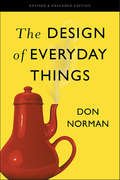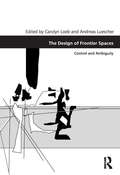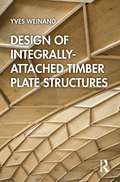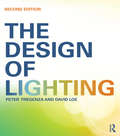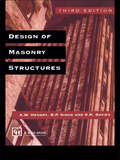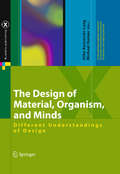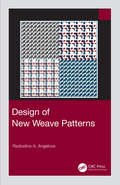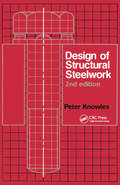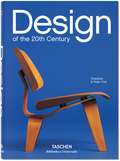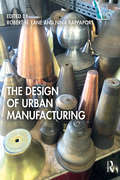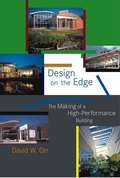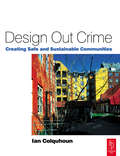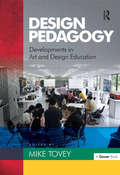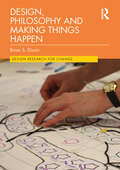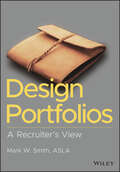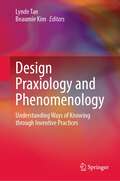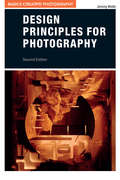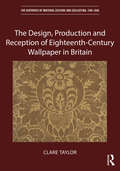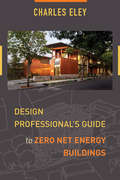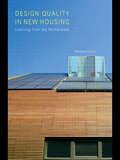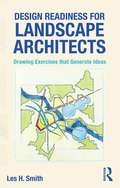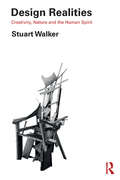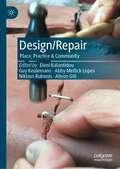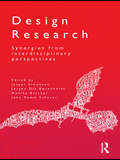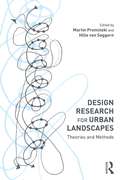- Table View
- List View
The Design of Everyday Things: Revised and Expanded Edition
by Don NormanOne of the world's great designers shares his vision of "the fundamental principles of great and meaningful design", that's "even more relevant today than it was when first published" (Tim Brown, CEO, IDEO). Even the smartest among us can feel inept as we fail to figure out which light switch or oven burner to turn on, or whether to push, pull, or slide a door. The fault, argues this ingenious -- even liberating -- book, lies not in ourselves, but in product design that ignores the needs of users and the principles of cognitive psychology. The problems range from ambiguous and hidden controls to arbitrary relationships between controls and functions, coupled with a lack of feedback or other assistance and unreasonable demands on memorization. The Design of Everyday Things shows that good, usable design is possible. The rules are simple: make things visible, exploit natural relationships that couple function and control, and make intelligent use of constraints. The goal: guide the user effortlessly to the right action on the right control at the right time. The Design of Everyday Things is a powerful primer on how -- and why -- some products satisfy customers while others only frustrate them.
The Design of Frontier Spaces: Control and Ambiguity (Design and the Built Environment)
by Andreas Luescher Carolyn LoebIn a globalizing world, frontiers may be in flux but they remain as significant as ever. New borders are established even as old borders are erased. Beyond lines on maps, however, borders are spatial zones in which distinctive architectural, graphic, and other design elements are deployed to signal the nature of the space and to guide, if not actually control, behaviour and social relations within it. This volume unpacks how manipulations of space and design in frontier zones, historically as well as today, set the stage for specific kinds of interactions and convey meanings about these sites and the experiences they embody. Frontier zones organize an array of functions to facilitate the passage of goods, information, and people, and to define and control access. Bringing together studies from Asia, Africa, the Middle East, Europe, and North America, this collection of essays casts a wide net to consider borders of diverse sorts. Investigations of contemporary political frontiers are set within the context of examinations of historical borders, borders that have existed within cities, and virtual borders. This range allows for reflection on shifts in how frontier zones are articulated and the impermanence of border emplacements, as well as on likely scenarios for future frontiers. This text is unique in bringing together a number of scholarly perspectives in the arts and humanities to examine how spatial and architectural design decisions convey meaning, shape or abet specific social practices, and stage memories of frontier zones that no longer function as such. It joins and expands discussions in social science disciplines, in which considerations of border practices tend to overlook the role of built form and material culture more broadly in representing social practices and meanings.
Design of Integrally-Attached Timber Plate Structures
by Yves WeinandDesign of Integrally-Attached Timber Plate Structures outlines a new design methodology for digitally fabricated spatial timber plate structures, presented with examples from recent construction projects. It proposes an innovative and sustainable design methodology, algorithmic geometry processing, structural optimization, and digital fabrication; technology transfer and construction are formulated and widely discussed. The methodology relies on integral mechanical attachment whereby the connection between timber plates is established solely through geometric manipulation, without additional connectors, such as nails, screws, dowels, adhesives, or welding. The transdisciplinary design framework for spatial timber plate structures brings together digital architecture, computer science, and structural engineering, covering parametric modeling and architectural computational design, geometry exploration, the digital fabrication assembly of engineered timber panels, numerical simulations, mechanical characterization, design optimization, and performance improvement. The method is demonstrated through different prototypes, physical models, and three build examples, focusing specifically on the design of the timber-plate roof structure of 23 large span arches called the Annen Headquarters in Luxembourg. This is useful for the architecture, engineering, and construction (AEC) sector and shows how new structural optimization processes can be reinvented through geometrical adaptions to control global and local geometries of complex structures. This text is ideal for structural engineering professionals and architects in both industry and academia, and construction companies.
The Design of Lighting
by Peter Tregenza David LoeThis fully updated edition of the successful book The Design of Lighting, provides the lighting knowledge needed by the architect in practice, the interior designer and students of both disciplines. The new edition offers a clear structure, carefully selected material and linking of lighting with other subjects, in order to provide the reader with a comprehensive and specifically architectural approach to lighting. Features of this new edition include: technical knowledge of lighting in the context of architectural design; an emphasis on imagination in architectural light and presentation of the tools necessary in practice for creative design; additional chapters on the behaviour of light and on the context of design; a strong emphasis on sustainable design and energy saving, with data and examples; analyses of actual lighting schemes and references to current standards and design guides; an up-to-date review of lamp and lighting technology, with recommendations on the choice of equipment; a revision of the calculation section, with examples and step-by-step instructions, based on recent student feedback about the book.
Design of Masonry Structures
by A. W. Hendry B. P. Sinha S. R. DaviesThis edition has been fully revised and extended to cover blockwork and Eurocode 6 on masonry structures. This valued textbook:Discusses all aspects of design of masonry structures in plain and reinforced masonry.summarizes materials properties and structural principles as well as describing structure and content of codes.Presents design procedures
The Design of Material, Organism, and Minds
by Michael Hampe Silke Konsorski-LangDesign is eminent throughout different disciplines of science, engineering, humanities, and art. However, within these disciplines, the way in which the term design is understood and applied differs significantly. There still is a profound lack of interdisciplinary research on this issue. The same term is not even guaranteed to carry the same meaning as soon as one crosses over to other disciplines. Therefore, related synergies between disciplines remain largely unexplored and unexploited.This book will address design in the hope of promoting a deeper understanding of it across various disciplines, and to support Design Science as a discipline, which attempts to cover the vast number of currently isolated knowledge sources.
Design of New Weave Patterns
by Radostina A. AngelovaThis book presents a systematic study on methods used for the creation of weave patterns for simple structures. Firstly, it explains known techniques for designing new weave patterns classified as patterns merge, motifs, patterns insertion and change of the displacement number. These are discussed as possibilities to create different textures and weaving effects supported by figures of patterns, colour view, and fabric appearance simulation. Secondly, it explains original methods for design of new weave patterns based on Boolean operations, musical scores, written texts and braille alphabet, including transformations performed, advantages/disadvantages, possible applications and designs.
Design of Structural Steelwork
by P.R. KnowlesThis second edition of Design of Structural Steelwork presents the essential design aspects of steel as a structural material. It has been carefully revised and updated to provide a modern introduction to the subject, assuming only a basic knowledge of structural analysis and solid mechanics.
Design of the 20th Century
by Fiell Charlotte Peter FiellThe bible of 20th-century design: From Art Nouveau to minimalism and everything in between Poised at the start of the 21st century, we can see clearly that the previous century was marked by momentous changes in the field of design. Aesthetics entered into everyday life with often staggering results. Our homes and workplaces turned into veritable galleries of style and innovation. From furniture to graphics, it`s all here - the work of artists who have shaped and recreated the modern world with a dizzying variety of materials. From the organic to the geometric, from Art Deco, through to Pop and High-Tech, this book contains all the great names - Harry Bertoia, De Stijl, Dieter Rams, Philippe Starck, Charles and Ray Eames, to name only a very few. This essential book is a comprehensive journey through the shapes and colors, forms and functions of design history in the 20th century. An A-Z of designers and design schools, which builds into a complete picture of contemporary living. Lavishly illustrated, this is design in the fullest sense. About the Series: Bibliotheca Universalis -- Compact cultural companions celebrating the eclectic TASCHEN universe at an unbeatable, democratic price! Since we started our work as cultural archaeologists in 1980, the name TASCHEN has become synonymous with accessible, open-minded publishing. Bibliotheca Universalis brings together nearly 100 of our all-time favorite titles in a neat new format so you can curate your own affordable library of art, anthropology, and aphrodisia. Bookworm's delight -- never bore, always excite!
The Design of Urban Manufacturing
by Nina Rappaport Robert N. LaneAmerican cities are rediscovering the economic and social value of urban manufacturing. However, urban manufacturing is often invisible and poorly understood in terms of urban design, architecture, and policy. The Design of Urban Manufacturing brings a multidisciplinary approach to a new complex reality that urban manufacturing now sits squarely at the intersection of research, education, and neighborhood revitalization. Using cases studies from across North America and beyond, this book presents innovative approaches not only to the design of districts and buildings, but to the design of policy as well: the special roles that governments, local development corporations, and not-for-profit organizations all have to play in supporting manufacturing. With striking color illustrations throughout, this book presents current models for working neighborhoods where factories enable fine-grained mixed-use communities and face-to-face contact while creatively solving the very real problems of goods movement and functional buildings. Design guidelines and policy recommendations are calibrated to different types of production districts. The Design of Urban Manufacturing is the essential resource for policy makers, designers, and students in urban design, planning, and urban and economic development.
Design Out Crime
by Ian ColquhounHere is a book about the practical design of communities and housing in which people can enjoy a good quality of life, free from crime and fear of crime.Recognising that crime, vandalism and anti-social behaviour are issues of high public concern, and that the driving forces behind crime are numerous, this book argues that good design can help tackle many of these issues. It shows how, through integrating simple crime prevention principles in the design process, it is possible, almost without notice, to make residential environments much safer.Written from the perspective of an architect and town planner, this book offers practical design guidelines through a set of accessible case studies drawn from the UK, USA, The Netherlands and Scandinavia. Each example illustrates how success comes when design solutions reflect local characteristics and where communities are truly sustainable; where residents feel they belong, and where crime is dealt with as part of the bigger picture of urban design.
Design Pedagogy: Developments in Art and Design Education
by Mike ToveyDesign Pedagogy explains why it is vital for design students that their education helps them construct a ’passport’ to enter the professional sphere. Recent research into design teaching has focused on its signature pedagogies, those elements which are particularly characteristic of the disciplines. Typically based on core design theory, enlivened by approaches imported to the area, such work has utility when it recognizes the visual language of designing, the media of representation used, and the practical realities of tackling design questions. Increasingly the 21st century sees these activities in a global context where the international language of the visual artefact is recognized. This book draws on recent work in these areas. It includes a number of chapters which are developed from work undertaken during the period of special funding for centres of teaching excellence in the UK up until 2010. Two of those in design have provided the basis for research and innovative developments reported on here. They have helped to enliven the environment for design pedagogy research in other establishments which are also included. Design students need support for the agile navigation through the design process. Learning experiences should develop students’ natural motivations and professionalise motivation to create a resilient, informed and sustainable capacity. This is the essence of ’transformative learning’. This collection explores how design education is, in itself, a passport to practice and showcases how some of the key developments in education use techniques related to collaboration, case studies and experience to motivate students, enable them to express their identity, reflect and learn.
Design, Philosophy and Making Things Happen (Design Research for Change)
by Brian S. DixonDrawing from the work of Dewey, Wittgenstein and Heidegger, this book aims to relate a series of philosophic insights to the practice of engaging in design research for change. These insights are explored and presented as a set of potential strategies for grounding transformative design research within an intellectual context which both embraces and celebrates experience, process and uncertainty. Chapter by chapter, through theory, practical examples and case studies, an accessible narrative opens up around the coupled themes of existence and experience, language and meaning and knowing and truth. The outcome is a rich and detailed perspective on the ways in which philosophy may afford design research for change a means to both explain, as well as understand, not only what it is and what it does, but also what it could be. The book will be of interest to scholars working in design studies, design theory and design research.
Design Portfolios: A Recruiter's View
by Mark W. SmithUnique perspective of a seasoned designer and veteran A/E industry recruiter regarding what design industry recruiters actually look for in a Design Portfolio Design Portfolios: A Recruiter’s View provides a student-friendly guide, written from the perspective of a designer and design industry recruiter, on what recruiters look for as they review a design portfolio. It shows students how to create a professional-quality portfolio that will get them to that all-important next step in the recruiting process—the interview. Using a unique plan of action, “The Four S’s”, the book presents an organizational mindset focused on the added value of telling your Story, revealing your Style, proclaiming your Substance, and Sharing your uniqueness effectively. In today’s competitive market, a winning portfolio is much more than a simple accounting of digital skills and volumes of high-resolution graphics. This book shows students what recruiters really value and how to ensure their portfolios make the right impression. Design Portfolios: A Recruiter’s View explains: How to develop a memorable organizational approach around story, style, substance, and sharing and create a winning portfolio Answers to the key questions students ask to fill in gaps in their academic instruction Real examples of resumes, cover letters, and portfolios that reveal what is needed for success Years of “big picture” insight gained from actual portfolio reviews during the author’s time as a designer and recruiter Aimed at the inexperienced design student rather than the practicing professional, Design Portfolios: A Recruiter’s View is an easy-to-understand and constructive guide that is incredibly helpful to young designers with project histories that consist only of academic and internship work.
Design Praxiology and Phenomenology: Understanding Ways of Knowing through Inventive Practices
by Lynde Tan Beaumie KimThis book offers insight into designerly ways of knowing from the perspectives of experts and professionals engaging in diverse forms of design in workplaces and other public domains. It also aids in the understanding of design practices from designers’ viewpoints via case studies. By pursuing a reflective inquiry in their design epistemology (designerly ways of knowing), design praxiology (practices of design), or design phenomenology (forms of designs), self-studies of design practices, and presenting studies of designs, the authors of this book demonstrate how they influence the people and the object of inquiry or design. The case studies presented in this book also illustrate how designers develop their expertise, and provides inspiration for the incorporation of design-thinking and practice in education.
Design Principles for Photography
by Jeremy WebbIn an age over-saturated with photographic imagery, Design Principles for Photography demonstrates how design awareness can add a new level of depth to your images. By adapting and experimenting with the tried and tested techniques used by graphic designers every day, you can add dynamism and impact to your imagery, whatever the style or genre - something that today's editors, curators and publishers are all crying out for.The second edition includes examples of unsuccessful compositions, annotated images highlighting key techniques and an expanded glossary. There’s also a new section on movements in photography and their reflection in composition, including modernism, expressionism, and surrealism and interviews with international practitioners discussing how they’ve included design principles in their work. Featured topics: Basic design theory; the use of space; positional decisions; the elements of design; line; shape or form; space; texture; light; colour; pattern; rhythm; contrast; scale and proportion; abstraction; movement and flow; containment; emphasis and emotion; justaposition; incongruity; mood and emotion.
The Design, Production and Reception of Eighteenth-Century Wallpaper in Britain (The Histories of Material Culture and Collecting, 1700-1950)
by Clare TaylorWallpaper’s spread across trades, class and gender is charted in this first full-length study of the material’s use in Britain during the long eighteenth century. It examines the types of wallpaper that were designed and produced and the interior spaces it occupied, from the country house to the homes of prosperous townsfolk and gentry, showing that wallpaper was hung by Earls and merchants as well as by aristocratic women. Drawing on a wide range of little known examples of interior schemes and surviving wallpapers, together with unpublished evidence from archives including letters and bills, it charts wallpaper’s evolution across the century from cheap textile imitation to innovative new decorative material. Wallpaper’s growth is considered not in terms of chronology, but rather alongside the categories used by eighteenth-century tradesmen and consumers, from plains to flocks, from China papers to papier mâché and from stucco papers to materials for creating print rooms. It ends by assessing the ways in which eighteenth-century wallpaper was used to create historicist interiors in the twentieth century. Including a wide range of illustrations, many in colour, the book will be of interest to historians of material culture and design, scholars of art and architectural history as well as practicing designers and those interested in the historic interior.
Design Professional's Guide to Zero Net Energy Buildings
by Charles EleyIn the United States, direct energy use in buildings accounts for 39% of carbon dioxide emissions per year--more than any other sector. Buildings contribute to a changing climate and warming of the earth in ways that will significantly affect future generations. Zero net energy (ZNE) buildings are a practical and cost-effective way to reduce our energy needs, employ clean solar and wind technologies, protect the environment, and improve our lives. Interest in ZNE buildings, which produce as much energy as they use over the course of a year, has been growing rapidly.In the Design Professional's Guide to Zero Net Energy Buildings, Charles Eley draws from over 40 years of his own experience, and interviews with other industry experts, to lay out the principles for achieving ZNE buildings and the issues surrounding their development. Eley emphasizes the importance of building energy use in achieving a sustainable future; describes how building energy use can be minimized through smart design and energy efficiency technologies; and presents practical information on how to incorporate renewable energy technologies to meet the lowered energy needs. The book identifies the building types and climates where meeting the goal will be a challenge and offers solutions for these special cases. It shows the reader, through examples and explanations, that these solutions are viable and cost-effective.ZNE buildings are practical and cost-effective ways to address climate change without compromising our quality of life. ZNE buildings are an energizing concept and one that is broadly accepted yet, there is little information on what is required to actually meet these goals. This book shows that the goal is feasible and can be practically achieved in most buildings, that our construction industry is up to the challenge, and that we already have the necessary technologies and knowledge.
Design Quality in New Housing: Learning from the Netherlands
by Matthew CousinsThis book addresses the need for an in-depth study into design quality in new housing. The wider implications of policy and design are examined through a series of case studies of new housing projects in the UK and the Netherlands. Dutch interdisciplinary design and modern methods of construction are widely considered to be of the highest quality from which much can be learned and understood. This new guide offers architects the best practice for the design, policy and construction of new homes. The author considers proposals for the Thames Gateway and government incentives to create better quality housing, including the £60,000 house and design reviews. The wider implications of skills and training of architects, planners, design professionals and those parties involved in housing are also addressed.
Design Readiness for Landscape Architects: Drawing Exercises that Generate Ideas
by Les H. SmithDemands on landscape architecture students’ time are many and varied – when is there a chance to just sketch, and is it worth dedicating your time to the pursuit of drawing? This book shows how in short bursts you can build up your design skills using quick, relaxed sketches, which form the basis for full projects and studio work. This book will provide you with your own image library – sources of inspiration, guidance, and short-cuts to future designs. A variety of paths leading to design discovery, based upon experimental sketching methods, are discussed, demonstrated, and then put into action with valuable exercises. These exercises focus your sketching, giving hints and tips on what to look for, how to capture the essence of the object or location, and how to become a natural in the art of speedy visual communication. Real-life examples of the author’s built-works as a landscape architect show how professionals use these techniques in their own design creations. Design Readiness for Landscape Architects presents enjoyable and thought-stirring essays and drawing-based exercises to help students grow more facile and agile in their service as architects of the land, whether using tablets, paints, or pens and pencils.
Design Realities: Creativity, Nature and the Human Spirit
by Stuart WalkerDesign Realities explores a wide range of topics on creativity, design and spiritual well-being. Using critique, rational inquiry and personal reflection, Stuart Walker looks squarely at our contemporary condition, demonstrates how current assumptions and material expectations are becoming untenable and, most importantly, offers constructive new directions that are feasible, spiritually enriching, and hopeful. Comprising short essays, lyrical pieces, photo studies and longer discourses, this book takes us on a highly readable and enjoyable journey through some of the most pressing issues of our time. The innovative, intuitive format makes these topics readily accessible, while providing much food for thought about the changing nature of creativity in today’s world. Written by a leading thinker in the field, this highly original book offers readers something to ponder, discuss, contest and build upon.
Design/Repair: Place, Practice & Community
by Eleni Kalantidou Guy Keulemans Abby Mellick Lopes Niklavs Rubenis Alison GillThis collection of essays sheds light on repair as a disposition to material culture and a practice rooted in diverse sociocultural experiences. It provides an in-depth exploration of how repair manifests itself through the different lenses of governance, grassroots activism, transformative design and community-led initiatives. Most importantly, the chapters demonstrate how place-based approaches can reveal blueprints for social impact in circumstances of growing environmental and social precariousness.
Design Research: Synergies from Interdisciplinary Perspectives
by Jesper SimonsenDesign Research is a new interdisciplinary research area with a social science orientation at its heart, and this book explores how scientific knowledge can be put into practice in ways that are at once ethical, creative, helpful, and extraordinary in their results. In order to clarify the common aspects – in terms of features and approaches – that characterize all strands of research disciplines addressing design, Design Research undertakes an in-depth exploration of the social processes involved in doing design, as well as analyses of the contexts for design use. The book further elicits ‘synergies from interdisciplinary perspectives’ by discussing and elaborating on differing academic perspectives, theoretical backgrounds, and design concept definitions, and evaluating their unique contribution to a general core of design research. This book is an exciting contribution to this little explored field, and offers a truly interdisciplinary approach to the treatment of design and the design process. It is valuable reading for students in disciplines such as design studies and theory, participatory design, informatics, arts based education, planning, sociology, and interdisciplinary programmes in humanities and technology.
Design Research for Urban Landscapes: Theories and Methods
by Martin Prominski Hille SeggernWithin the spatial design disciplines, research through design as a tool and practice has often been neglected. This book provides a much-needed companion to the theories, methods and processes involved in using design-based research in landscape, architecture and urban design. Aimed specifically at researchers completing PhD projects, supervisors and designers working in practice, it covers applied approaches to help you to use design research in your work. With fully illustrated examples of original international design research PhDs from a variety of programme types, such as individual, structured and practice-based, Design Research for Urban Landscapes offers PhD candidates and supervisors a clear foundational pathway.
